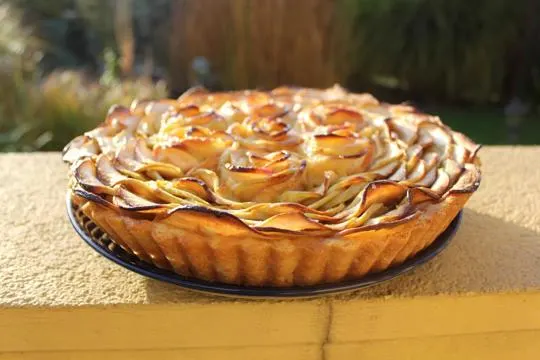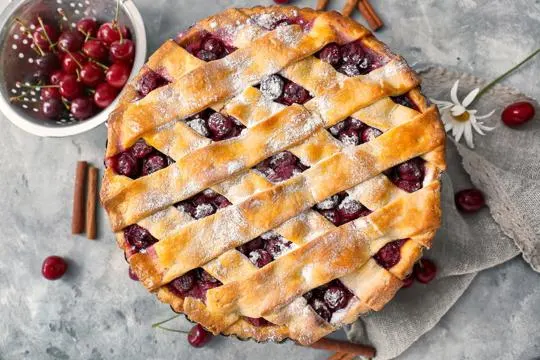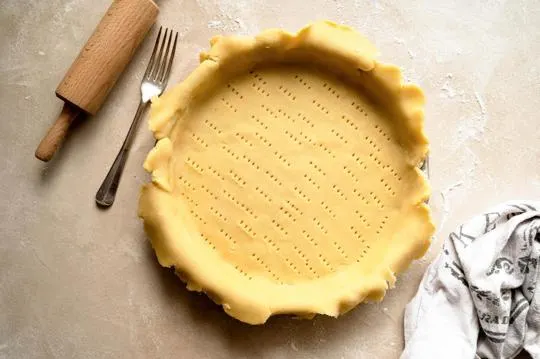Ever stood in the kitchen, tart pan in one hand and pie pan in the other, wondering what on earth the difference is? We’ve all been there.
Tart pans and pie pans might seem interchangeable, yet they’re as different as cookies and cake. It’s all in the details, folks. Tart pans boast a removable bottom, making them the go-to for those perfect dessert presentations. Pie pans, on the other hand, are deeper, with sloped sides to cradle all that yummy filling.
I remember the first time I tried swapping them; let’s just say my ‘pie’ looked more like a sad, deflated pancake.
In this showdown between tart and pie pans, we’re here to clear the air. No more kitchen standoffs.
What is a Tart Pan?

Tart pans, also known as fluted tart pans or quiche pans, are shallow, round baking dishes with sloping sides and a removable bottom.
They are specifically designed for tarts and quiches.
The fluted edges and removable bottom create the perfect tart crust.
A tart pan is different from a regular pie pan.
Its shape is shallower with sloping sides, whereas pie pans are deeper with straight sides.
This shape is great for making thin, crisp pastry shells.
The removable bottom allows for easy removal of the tart.
Tart pans come in various sizes and materials.
Metal and ceramic offer different heat distribution properties.
Some modern pans feature non-stick coatings.
When choosing between a tart pan and a pie pan, consider the recipe.
Pies are usually deeper and filled with fillings.
Tarts showcase toppings and require a shallower vessel.
A dedicated tart pan will help you make stunning tarts.
What is a Pie Pan?

The pie pan is a must-have baking tool.
It is used for making pies and holds and shapes the crust and filling.
It is usually made from aluminum, glass, or ceramic and comes in different sizes and depths.
The sloping sides of the pan make it easy to remove the baked pie.
It also gives the pie a beautiful, fluted edge.
The depth of the pan depends on the type of pie – some recipes call for deep-dish pans.
Some pie pans have removable bottoms or non-stick surfaces.
This helps to easily transfer and serve the pie and also keeps the shape and integrity of the pie.
The pie pan also ensures even heat distribution and a golden-brown, crispy crust.
Its flat bottom keeps the pie steady while baking.
A pie pan is essential for any baker or pastry chef wanting perfect pies.
Investing in a good quality pan helps to ensure delicious pies each and every time.
Differences Between Tart Pan and Pie Pan

Tart pans and pie pans are not the same.
Tart pans have shallow, straight sides and removable bottoms.
This makes it easier to take out the tart crust without breaking it.
Pie pans, however, are deeper and their sides slope.
This is good for keeping the generous fillings of a pie inside.
No removable bottoms on these pans.
Shape and Size
Tart pans and pie pans have a major role in how the final product looks.
Both pans serve a similar purpose, but have different dimensions and design.
Tart pans have shallow, fluted sides and a wider, shallower structure.
This allows for even heat distribution, resulting in a crispier crust.
The fluted edges add beauty and stop pastry from shrinking during baking.
Pie pans come in various shapes and sizes.
Deep-dish pans are great for pies with fillings such as fruit or custard.
High sides prevent overflow while baking.
Tart pans are usually smaller than pie pans.
They range from 8 to 10 inches in diameter, for individual portions or miniature tarts.
Pie pans can vary in size, depending on the recipe.
Tart pans often have removable bottoms or loose bases.
This makes it easier to remove the tart without damaging it.
Pie pans have fixed bottoms for stability during baking.
In conclusion, tart pans and pie pans are both used for baking pastries.
However, their structure and size set them apart.
The choice depends on whether you’re making individual tarts or pies with generous portions.
Depth and Sloping Sides
Tart pans and pie pans are distinguished by their depth and sloping sides.
Tart pans have shallower depths, typically between 1-2 inches, plus pronounced slopes.
This design allows for simple removal of tarts without harming their crusts.
Pie pans, on the other hand, have deeper depths ranging from 1.
5-3 inches.
Pie pans’ more gradual slopes accommodate thick and heavy fillings.
Tart pans may have removable bottoms or fluted edges for easy removal of the tart.
In conclusion, tart pans and pie pans both serve similar purposes but differ in depth and sloping sides for delicate tarts and hearty pies respectively.
Removability
Tart pans and pie pans have one significant difference: removability.
A tart pan is designed with a removable bottom, which allows for effortless removal of delicate tarts.
With this feature, the tart can be gently released onto a serving plate without damaging the crust.
On the other hand, traditional pie pans don’t have a removable bottom.
Pies are usually served directly from the pan, as removing them can be difficult.
Meaning, pies must be cut and served directly from the pan, instead of being presented whole on a plate.
Tart pans offer convenience and elegance when presenting delicate tarts.
The removable bottom sets it apart from traditional pie pans, which are best for serving pies directly from the pan.
In conclusion, removability is an important factor when deciding between tart pans and pie pans.
Tart pans offer easy release and presentation of delicate tarts, while pie pans are better for serving pies directly from the pan.
Purpose and Typical Recipes
Tart pan and pie pan both have a purpose in baking – to create scrumptious desserts and pastries.
But, they have some key differences that make them unique.
Tart pans are normally shallower than pie pans.
Plus, they have fluted edges.
This gives tarts their special look.
Usually, they are filled with sweet or savory pastry crusts.
And, ingredients like fruits, custard or chocolate ganache.
The shallow depth of the tart pan ensures even cooking and a crisp crust.
In contrast, a pie pan is deeper and does not have fluted edges.
Generally, pies are made with a double-crust or single-crust pastry dough.
Plus, with fillings like fruit, meat or vegetables.
The deeper depth of the pie pan can hold more filling.
Tart pans and pie pans have several other unique features.
Tart pans typically have removable bottoms or sides for easy removal of the tart.
Pie pans are usually made of materials that distribute heat evenly for thorough cooking.
The type of pan you use will impact the final result.
Tart pans offer an elegant presentation with even browning and great crust texture.
Pie pans allow for more filling without overflows during baking.
It’s all up to you whether you choose a tart pan or a pie pan.
Both have their own advantages when making pastries and desserts.
Similarities Between Tart Pan and Pie Pan

Tart and pie pans are distinct, yet share some remarkable resemblances.
Both pans are typically circular with fluted edges, flat bottoms, and raised sides.
This common feature allows even heat distribution and perfectly cooked crusts.
Additionally, they are usually made from aluminum or stainless steel for durability and heat conductivity.
These pans both offer non-stick properties, allowing for easy release of delicate pastries.
Furthermore, they are designed to withstand high temperatures without warping or distorting.
However, tart pans have removable bottoms and fluted edges that can be detached for serving.
This enables users to push up the base or remove the outer ring, displaying the filling.
Pie pans, on the other hand, have solid sides that remain intact throughout baking and serving.
Materials Used in Tart Pans and Pie Pans
Tart pans are usually made of metal – like aluminum or stainless steel.
This helps the crust turn out perfect.
Pie pans can be glass, ceramic or silicone.
Glass absorbs heat slowly and gives a crisp golden crust.
Ceramic looks stylish.
Silicone is flexible and easy to release the finished pie from.
Your choice of tart pans or pie pans depends on what you want and how you like to bake.
Conclusion
After discussing the key differences between a tart pan and pie pan, it is safe to conclude that both offer unique functions but are also very similar.
At the end of the day, you can pick which one best suits your needs in terms of baking delicious desserts.
If you want something light and fluffy go for a pie pan, while if you are looking for a decadent dessert with deep flavor and texture then go for a tart pan.
Don’t forget that when greasing pans larger than 9 inches more butter may be needed to make sure nothing sticks.
Lastly, go for metal pans since they conduct heat better and ensure even baking throughout.
Now that you’re equipped with all this knowledge about tart pans vs pie pans, let the baking begin.

Leave a comment